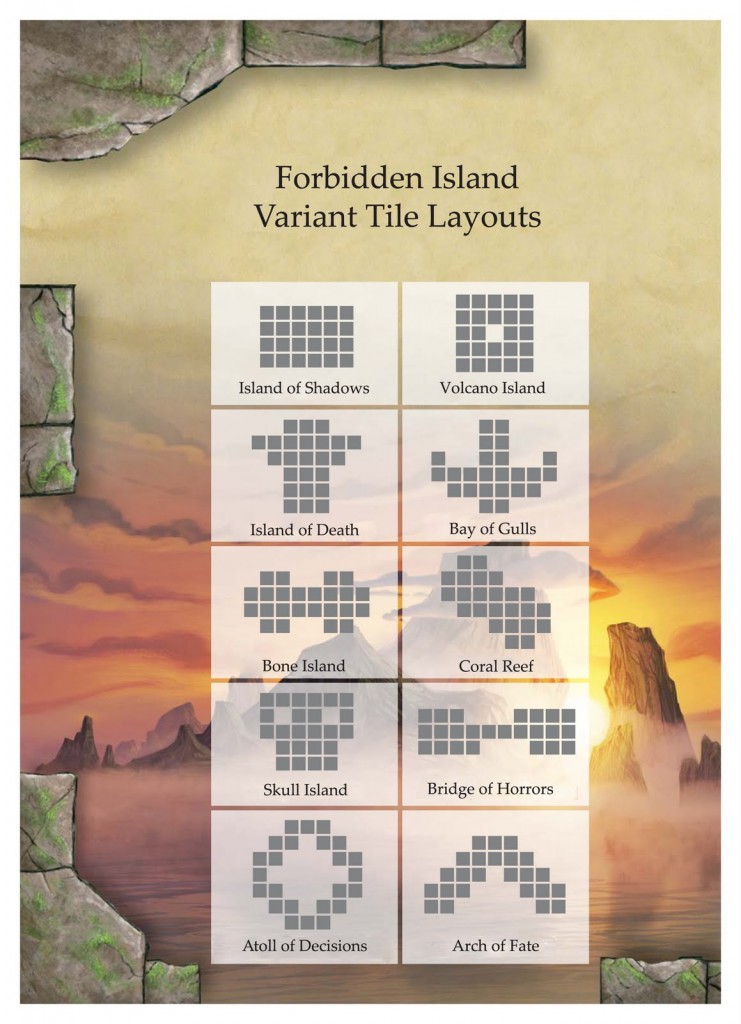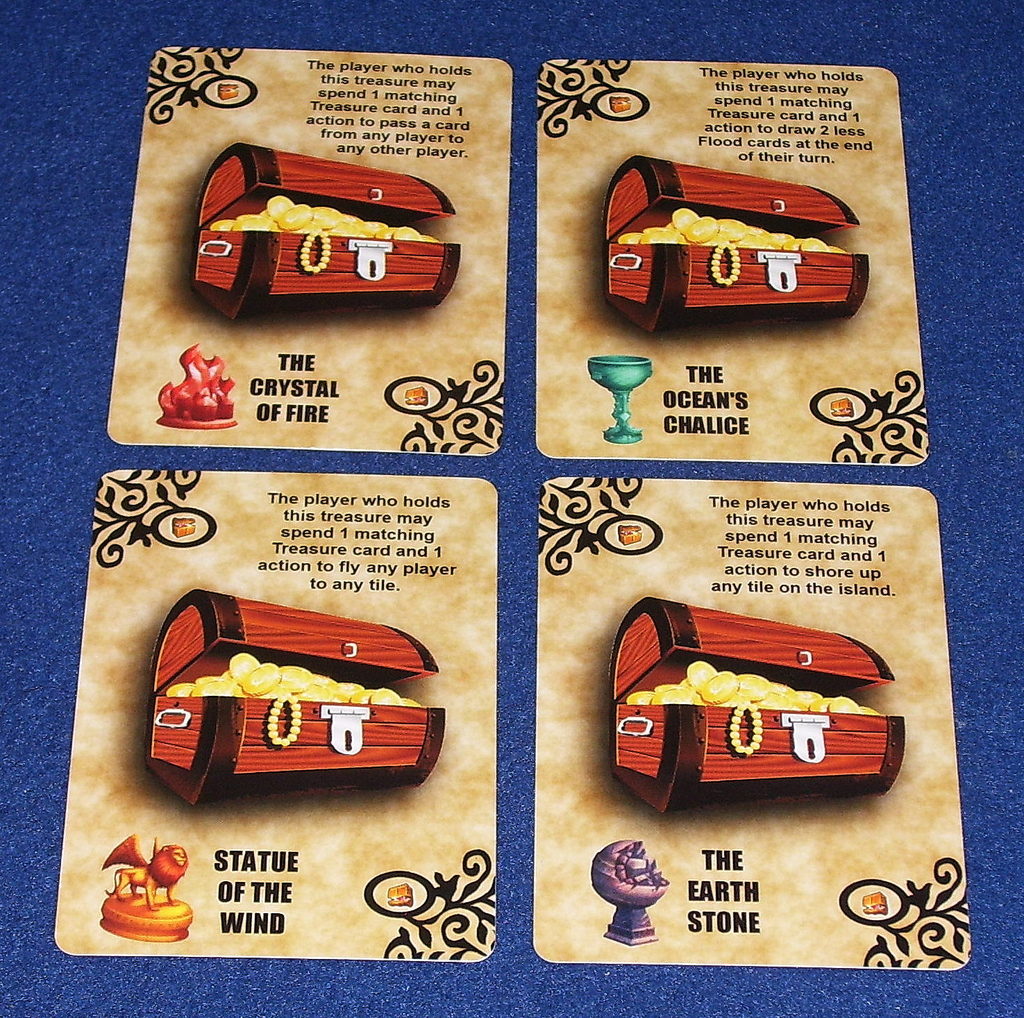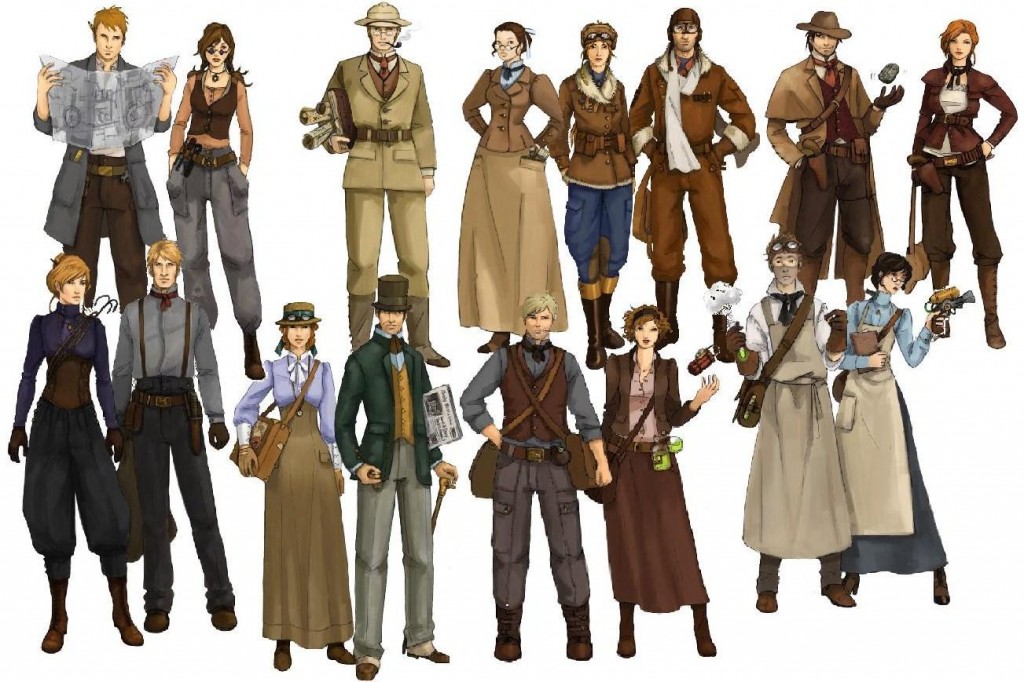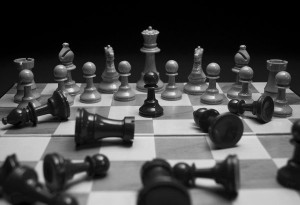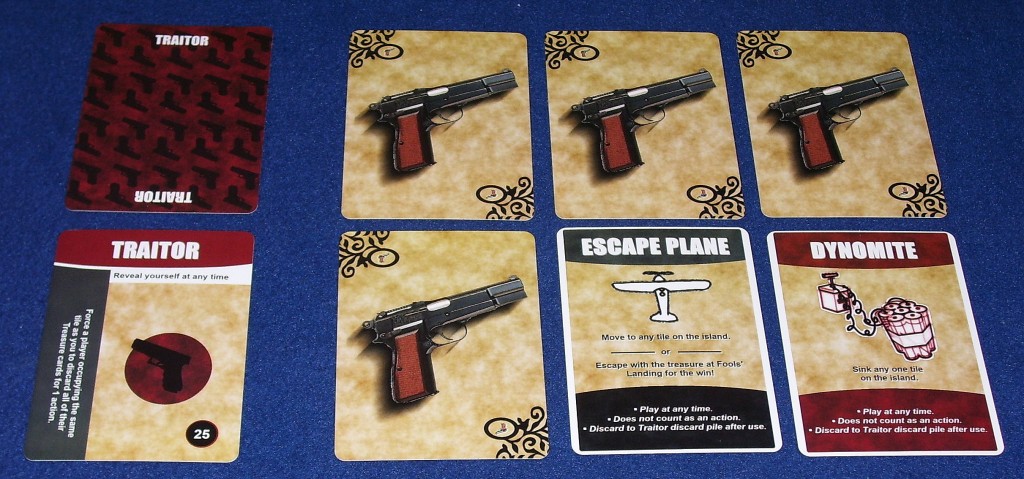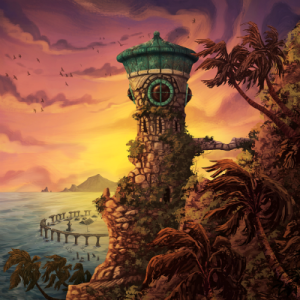 I picked up Forbidden Island a few years ago and was immediately struck at the elegance of its ease of play. It’s almost another Pandemic, but on a smaller scale. Players work together to collect four Treasures and escape while the island sinks around them. It’s “race against the clock” style keeps it short, exciting, and you can easily adjust the difficulty to your group’s comfort level. It’s a great Gateway Game that can still be enjoyed by more experienced players. Still, the question arises:
I picked up Forbidden Island a few years ago and was immediately struck at the elegance of its ease of play. It’s almost another Pandemic, but on a smaller scale. Players work together to collect four Treasures and escape while the island sinks around them. It’s “race against the clock” style keeps it short, exciting, and you can easily adjust the difficulty to your group’s comfort level. It’s a great Gateway Game that can still be enjoyed by more experienced players. Still, the question arises:
“How can we make it better?”
… No, not like that.
The Island Has . . . Changed!
One of the more obvious changes to any tile-based map is the layout. The locations are randomly placed at the beginning of every game of Island Fortress, so you already have all the variation you could want there. But how about the shape of the island itself?
In the German edition of the game, the publishers added a sheet with 10 new island layouts:
Even though it isn’t Gamewright’s fault for German publishers adding in some extra features, we can’t help but feel left out. Thanks to the power of the internet though, we who buy said translations are not left out in the cold.
These new maps have varying levels of difficulty, the “Island of Shadows” being relatively benign, while the “Atoll of Decisions” will likely be the most difficult Forbidden Island venture you ever face.
An added bonus to these new maps is how they emphasize the different abilities of your group – particularly the movement abilities. The Explorer’s ability to move diagonally really shines in the “Arch of Fate” or the “Atoll of Decisions”, while the Diver’s swimming will save your group on the “Bridge of Horrors”, and the Pilot… well, on every map he’s always been somewhat broken.
Treasure Powers
The island is sinking around you, and you finally have your hands on the legendary Statue of the Wind. As you examine the carvings, you wonder if there’s more to this hunk of metal than meets the eye…
Have you ever wondered why our intrepid heroes are so eager to find these lost artifacts? Surely if the Archeans could use them to control the elements, you could too?
With credit to Grudunza, this variant bestows additional powers upon the players. As long as you hold a Treasure, you may discard a matching Treasure Card as an action to activate its unique power. The Statue of the Wind gives a targeted Pilot ability, the Crystal of Fire a Messenger ability, the Ocean’s Chalice reduces the number of Flood Cards drawn, and the Earth Stone shores up Map Tiles.
Thematically they all work – except for the Crystal of Fire. I’m not quite sure how its ability relates to the element of flame, but I’ve been unable to come up with anything more appropriate either. So, I’ll go with it.
As for maintaining balance, the Treasures certainly help, but they are in no danger of tilting the difficulty too far in the players’ favor. They do make it easier to tackle the Elite and Legendary levels, but success is in no way guaranteed, or even reliably expected.
Treasure Drawbacks
These often appear along with the powers as a way to balance them out. The first, and most common, is for the Treasures to “phase” in and out. That is, when you have 4 matching Treasure Cards and move to one of the corresponding locations, you roll a dice to see if the Treasure is there or at the other location. If you go to the other, you roll again to see if it’s at that one or has returned to the first location.
 I cannot describe how frustrating this can be. I bounced back and forth between two temples for five turns before I managed to get my hands on a Treasure.
I cannot describe how frustrating this can be. I bounced back and forth between two temples for five turns before I managed to get my hands on a Treasure.
Now, I understand the confusion around the idea that a legendary artifact can be in two places at once. I even agree that from a thematic point of view it requires a fair bit of rationalization. But this particular variant is most definitely not for me.
The random luck element appeals to some players, and perhaps you are one such individual. So, by all means, try it out yourself and let us know what you think.
A drawback that I loved, however, was the Heavy Treasures. This makes the assumption that these Treasures can be bulky, so that each one you hold reduces your number of actions by one.
Thematically, it makes sense that the weight might slow you down. But it also forces players to work more as a team, trading Treasures between themselves so that no one gets left behind.
If you’re using the Treasure Powers variant, it also serves as a nice offset to those abilities.
Meet the New Guys!
Another quite common variant is the imagining of new Player Roles, expanding on the established Messenger, Navigator, Engineer, Pilot, Diver and Explorer. Rising out of the question of, “Wouldn’t it be cool if I could do this…”, the difficulty always lies in finding balance. Most player-made abilities seem to swing between too powerful and utterly ineffectual. However, if you’re interested in some new ideas for your game, meet the new adventurers:
In my opinion, the best list of new Roles to experiment with can be found here:
These 18 characters bring new abilities to the table, be it movement, sandbagging, or manipulation of flood tiles. For example:
- The Doctor rescues players on sinking tiles by moving them to any other tile still in play, not necessarily adjacent.
- The Strategist takes an extra turn if he has less than 3 cards in his hand.
- The Carpenter draws 1 less Flood Card from the Flood Deck.
Having tested all of them, I can attest that each one brings something relevant to the way the game plays without overpowering the balance, with one exception: the Archaeologist. His ability to capture treasures from any tile was a tad on the powerful side, but on higher water levels can be just the boost your team needs.
While I do enjoy the new Roles, I will admit that that the new abilities do not always make sense flavor-wise (How does the Rock-Climber move in an L shape?). Regardless, overall it makes for a fun experience that adds a lot of new variety to the game.
I also found some people discussing the ideas of “multiclassing”, allowing players to use two Roles for the same character. I experimented with the idea a little, but I don’t think it really helps the experience, even if you restrict when and how the second one can be used. I ultimately found it to be unnecessary.
If you’re sold on the idea of a secondary Role, however, how about a secret one? What if, within your intrepid band of treasure hunters and thrill seekers, one of you was not quite what they seemed? Someone with an agenda of their own, out to get the rest of the group? What if one of you is a…
Traitor?
Credit for this new Role goes to CoreyRIT, with a few tweaks from Kentalot. The way this variant works is this:
At the beginning of the game take out the Traitor card and each player chooses a role as usual. (If you’re playing with the additional Roles, shuffle the Traitor back in with the remainder.) Then, deal a hidden Role to each player. (If you are not using additional Roles, you can simply take 6 playing cards and designate one as the traitor, dealing them face down to each player.) Each player may look at his second Role, but may not reveal it to the other players. Any secondary Role that is not the Traitor has no effect, but is still kept face down by the player until the Traitor has been revealed.
The Traitor’s goal is to escape the island with one of the treasures before the rest of the group finds the others and escapes. The other team members must escape with the other Treasures first. All players still lose if Fool’s Landing is lost.
A player may reveal themselves as the Traitor at any time, but they will lose whatever role they had in the in the process. Once revealed, they have access to the Traitor Deck, consisting of 5 Guns, 1 Dynamite, and 1 Escape Plane. They still have a maximum hand size of five, and they may choose to draw from either Deck. The Dynamite can destroy any tile except Fools’s Landing. The Traitor can escape using either the Escape Plane, or the Helicopter Lift per usual.
The Traitor may gain a Treasure the normal way (through matching Treasure Cards) or by discarding four cards as a free action to steal one from another player. However, this can only be done after all 4 Treasures have been found.
If the Traitor gains a Treasure the normal way, he or she must immediately reveal themselves, draw two Treasure cards, and end the turn without using any special abilities until their next turn. This prevents the Traitor from making an overly easy exit. (And probably leaves room for some monologuing.)
If you are playing with the Treasure Powers Variant, the revealed Traitor cannot be targeted by their abilities. (i.e., you cannot use the Statue of Wind to teleport the Traitor to a tile surrounded by water). Likewise, the Traitor cannot use Treasure Powers, for similar reasons.
If the revealed Traitor is moving onto a tile containing any other player, it takes two actions instead of one, reflecting how he has to sneak past the others to fulfill his objective. Additionally, if at least two other players are on the same tile as the Traitor, one of them may use two actions to take a Treasure away from the Traitor.
Being Bold
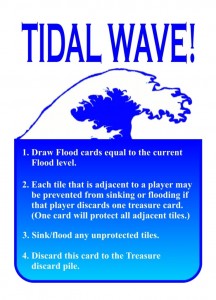 An alternative option for those who feel that the basic game just difficult enough, you can always try John Hodge’s Challenge Deck. It incorporates the Heavy Treasure Variant, as well as 8 others, including:
An alternative option for those who feel that the basic game just difficult enough, you can always try John Hodge’s Challenge Deck. It incorporates the Heavy Treasure Variant, as well as 8 others, including:
- Off to a Wet Start: After the Island has been built, remove two tiles from the game.
- It’s a Tough Job: Each adventurer’s ability can only be used 4 times in a game.
- Home Sweet Home: Players cannot use their character’s ability if their starting location has been removed from play.
…Or, you can just shuffle Grudunza’s Tidal Wave card into your deck and watch the ground just sink away…
Multiplayer Plus
Finally, if you’re looking to play with more than the recommended 2-4 players, there is an easy fix to help scale the game’s balance with your preferred number of explorers.
The more people that are in your party, the faster the waters will rise. Also, the Treasure Deck is a finite resource. With a large number of players holding all their cards in hand, the Treasure Deck will produce nothing but Waters Rise cards, sinking any hope your group has of victory. I suggest that in a 5-player game the maximum hand size should be reduced reduced to three or four. For a 6-player game the hand size is two or three. Anything higher, hand size is two. To offset this, players on the same tile may combine their hands to collect Treasures. This way you keep actual Treasure Cards in circulation, slowing down the rate of flooding enough to have a chance. It’s not a great chance, but it’s a chance all the same.
You can find the card images for the Variant Maps, Roles, Treasure Powers, and Traitor Deck at these links:
Option 1, including Traitor Cards. Click here for finished picture example.
Option 2. Click here for finished picture example.
Author’s Note:
A photographer/ gamer is working on improved art cards for the base game and several variants mentioned in this article. At the time of this writing, he is not finished yet, but if you’re interested in looking at his streamlined look (including a difficulty meter on each Variant Map), check out this picture here. You can see more of his progress at his thread on BGG.
![]()
Nathan Crocco is a regular contributor to the site. If you have particular game variants you wish to request of him, he can be reached at nathan@cardboardrepublic.com.
You can discuss this article over on our forums!
Photo Credits: Pegasus Expedition by Anendda-Rysden; “New Guys” by Werdandi; Traitorous Chess piece by Minx-is-aperfect.


